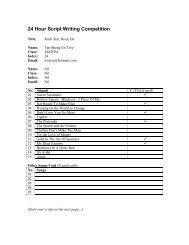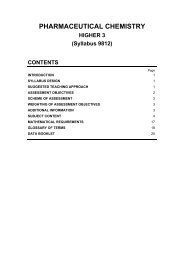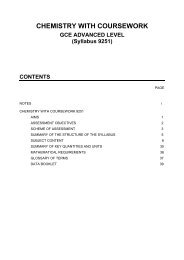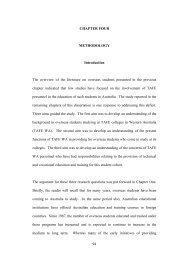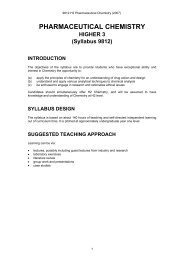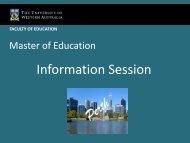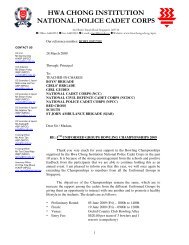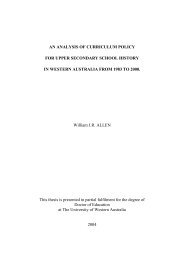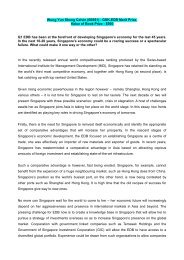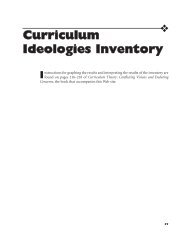EDUC 8678 - Pre-reading - Curriculum and its discontents
EDUC 8678 - Pre-reading - Curriculum and its discontents
EDUC 8678 - Pre-reading - Curriculum and its discontents
Create successful ePaper yourself
Turn your PDF publications into a flip-book with our unique Google optimized e-Paper software.
<strong>Curriculum</strong> <strong>and</strong> Its Discontents<br />
Author(s): Philip W. Jackson<br />
Source: <strong>Curriculum</strong> Inquiry, Vol. 10, No. 2 (Summer, 1980), pp. 159-172<br />
Published by: Blackwell Publishing on behalf of the Ontario Institute for Studies in<br />
Education/University of Toronto<br />
Stable URL: http://www.jstor.org/stable/1179779<br />
Accessed: 26/01/2010 02:25<br />
Your use of the JSTOR archive indicates your acceptance of JSTOR's Terms <strong>and</strong> Conditions of Use, available at<br />
http://www.jstor.org/page/info/about/policies/terms.jsp. JSTOR's Terms <strong>and</strong> Conditions of Use provides, in part, that unless<br />
you have obtained prior permission, you may not download an entire issue of a journal or multiple copies of articles, <strong>and</strong> you<br />
may use content in the JSTOR archive only for your personal, non-commercial use.<br />
Please contact the publisher regarding any further use of this work. Publisher contact information may be obtained at<br />
http://www.jstor.org/action/showPublisher?publisherCode=black.<br />
Each copy of any part of a JSTOR transmission must contain the same copyright notice that appears on the screen or printed<br />
page of such transmission.<br />
JSTOR is a not-for-profit service that helps scholars, researchers, <strong>and</strong> students discover, use, <strong>and</strong> build upon a wide range of<br />
content in a trusted digital archive. We use information technology <strong>and</strong> tools to increase productivity <strong>and</strong> facilitate new forms<br />
of scholarship. For more information about JSTOR, please contact support@jstor.org.<br />
Ontario Institute for Studies in Education/University of Toronto <strong>and</strong> Blackwell Publishing are collaborating<br />
with JSTOR to digitize, preserve <strong>and</strong> extend access to <strong>Curriculum</strong> Inquiry.<br />
http://www.jstor.org
<strong>Curriculum</strong> <strong>and</strong> Its Discontents<br />
PHILIP W. JACKSON<br />
University of Chicago<br />
They had traveled a long way. Their horses bore marks of the journey;<br />
flanks caked with mud, manes matted with dust. At last, the end was near.<br />
Dismounting, the pair walked the final few yards on foot. At the edge of the<br />
cliff, they paused <strong>and</strong> gazed upon the scene below. The younger of the two,<br />
tugging at his partner's arm, broke the silence.<br />
"Behold," he said, gesturing at the view that lay before them, "Yon lies<br />
the field of curriculum. So vast <strong>and</strong> inviting. Such a worthy object of<br />
contemplation. So ready for the harvest, ripe for the h<strong>and</strong>s of willing<br />
workers. But wait! What's this? Can it be? Why is there not more<br />
movement? Why does it lie so still? Tell me, good father, is it... is it alive?<br />
Or is it ... could it be... (gulp!) ... dead?"<br />
I.<br />
The introductory vignette is sheer hokum, of course, inspired at some<br />
subconscious level, I suspect, by memory traces left over from viewing Star<br />
Wars a couple of years ago. The speaker's query, however, is not a figment<br />
of my imagination. Oddly enough, a question very much like the one<br />
raised by our fictitious traveler has been preying on our collective mind of<br />
late, or so it would seem if we were to judge by the writings of several<br />
educators, including at least two who have had the honor of addressing this<br />
division of AERA in recent years.<br />
To the best of my knowledge, my former colleague, Joseph Schwab, was<br />
the first one within the recent past to raise this ominous query. (The<br />
adjective ominous seems necessary because, through our exposure to B-<br />
<strong>Pre</strong>sented as the invited address to Division B of the American Educational<br />
Research Association, San Francisco, April 1979.<br />
? 1980 by The Ontario Institute for Studies in Education. Published by John Wiley & Sons, Inc.<br />
CURRICULUM INQtJIRY 10:2 (1980) 0362-6784/80/0010-0159$01.40
160<br />
PHILIP W. JACKSON/CI<br />
rated movies <strong>and</strong> other forms of melodrama, we have come to expect the<br />
worst when circumstances require determining whether death is apparent<br />
or real.) Actually, Schwab answered the question without even bothering<br />
to ask it in the opening lines of his widely read essay "The Practical: A<br />
Language for <strong>Curriculum</strong>." The year was 1970. Herewith, Schwab's<br />
delivery of the bad news.<br />
"I shall have three points," he began, innocently enough. "The first is<br />
this: The field of curriculum is moribund. It is unable by <strong>its</strong> present<br />
methods <strong>and</strong> principles to continue <strong>its</strong> work <strong>and</strong> contribute significantly<br />
to the advancement of education" (Schwab 1978, p. 287).<br />
For all <strong>its</strong> starkness, Schwab's health bulletin did contain a ray of hope,<br />
though <strong>its</strong> light was faint indeed. As we know, the word moribund allows<br />
within <strong>its</strong> meaning for the possibility of a miraculous recovery, but, as we<br />
also know, the chances of that happening are mighty slim. In short, the<br />
message could hardly be called optimistic. The field of curriculum may not<br />
have been completely gone at the time Schwab took <strong>its</strong> pulse, but if we were<br />
to believe his prognosis, <strong>its</strong> end was close at h<strong>and</strong>.<br />
Just how close the end really was back in 1970 has been brought into<br />
question by subsequent <strong>reading</strong>s of the vital signs. Consider, for example,<br />
Dwayne Huebner's address to this division six years after Schwab's gloomy<br />
pronouncement. Huebner's debt to Schwab's initial pessimism was made<br />
explicit in the title of his paper-"The Moribund <strong>Curriculum</strong> Field: Its<br />
Wake <strong>and</strong> Our Work" (1976). But the title also revealed Huebner's basic<br />
uncertainty about whether the patient was yet alive or had long since<br />
crossed the bar. For if the field was in fact still moribund, as Huebner<br />
described it, why talk about a wake? A death watch, perhaps. Even a vigil<br />
might sound all right. But "The Moribund <strong>Curriculum</strong>: Its Wake..."?<br />
That did seem to be rushing things, or so I felt on first pondering the<br />
meaning of Huebner's title.<br />
In the body of his paper, Huebner went on to clarify the matter<br />
somewhat, though there, too, a trace of ambiguity continued to nag the<br />
close reader. For example, toward the end of his remarks Huebner<br />
emphatically declared, "The curriculum field of the past one hundred<br />
years is not just moribund; for all practical purposes it is dead" (p. 165).<br />
"Fair enough," the consciousness behind my skimming eye replied,<br />
"time to exchange the physician for the mortician." "But wait a minute," a<br />
reflective thought broke in, "what about the maddening phrase 'for all<br />
practical purposes'? What does that mean? Is Huebner, with that qualifier,<br />
trying to make the distinction we hear so much of these days: that between<br />
real death <strong>and</strong> clinical death? Is he saying that the curriculum field has no<br />
more brain activity, but with artificial help <strong>its</strong> heart beats on?"<br />
Almost as if he had heard my question, Huebner proceeded to speak<br />
like a man who had surreptitiously pulled the plug. The telltale sign of his<br />
guilt was a sudden switch in verb tense, from present to past. He turned to<br />
the question of why the field of curriculum died. He went on to assure his<br />
readers that there could be no hope of a renascence. The only consolation<br />
he offered to those who grieved was some vague talk about the possibility of<br />
a reincarnation, but to follow these thoughts would take us deeper into the
CURRICULUM AND ITS DISCONTENTS<br />
161<br />
body of his thesis than present purposes allow. This passing comment on<br />
his paper is merely intended to show that Huebner, like Schwab, found it<br />
useful to muse on the question of whether the curriculum field was alive or<br />
dead. Also like Schwab, he arrived, with some waffling, I fear, at a gloomy<br />
conclusion.<br />
In 1977 <strong>and</strong> again in 1978, William Pinar of the University of Rochester<br />
delivered two papers at the annual meeting of the AERA, each of which<br />
helped to keep alive the question of the curriculum field's state of health.<br />
In the first of these, entitled "The Reconceptualization of <strong>Curriculum</strong><br />
Studies," Pinar (1978b) referred specifically to the earlier observations of<br />
Schwab <strong>and</strong> Huebner, though in doing so he seemed as confused as I have<br />
been about their final judgment. When it came to reporting on what<br />
Schwab <strong>and</strong> Huebner had said, Pinar could not decide whether or not a<br />
definitive judgment had been reached. So he decided to play it safe by<br />
noting that the traditional curriculum field had been declared "terminally<br />
ill or already deceased" (italics mine, p. 207).<br />
As for himself, however, Pinar seemed resigned to the more severe of the<br />
two judgments, for in the sentence immediately following the one with the<br />
ambiguous "or," he referred to the field's "demise." He then talked about an<br />
"heir to the field," thus introducing thoughts of wills, last testaments, <strong>and</strong><br />
the like. Such talk leaves little doubt that Pinar either believed the end was<br />
past, or, like Huebner's wake, was rushing things a bit. Whichever interpretation<br />
we accept, Pinar's 1977 pronouncements could hardly be called<br />
gay-spirited. If not overtly mournful, they were at least draped in black.<br />
By last year, however, in his state-of-the-art address to Division B of the<br />
AERA, Pinar (1978a) was in a more cheerful mood. In his remarks he made<br />
no mention of death <strong>and</strong> dying. Instead, he described the state of the field as<br />
being, "fragmented <strong>and</strong> arrested." "The state of the field is arrest," he<br />
reiterated in his concluding paragraph, thus seeming to ab<strong>and</strong>on all<br />
reference to the earlier worry. Yet, for me, <strong>its</strong> echo could be heard in that<br />
final judgment, for is there not something deathlike in the word arrest?<br />
Perhaps I have become hypersensitive to such imagery through exposure<br />
to the views already discussed, but Pinar's words suggest the most final of<br />
all diagnoses: a cardiac arrest. Thus, the thanatotic fantasy, which Pinar<br />
had entertained earlier <strong>and</strong> which seems to have captured the imagination<br />
of Schwab, Huebner, <strong>and</strong> others, was gone perhaps, but not forgotten.<br />
My impatience with this lugubrious talk about the curriculum field's<br />
last gasps should be obvious by now. In fact, if my impatience had a voice<br />
of <strong>its</strong> own, <strong>and</strong> if it were allowed to join the morbid musing long enough to<br />
have <strong>its</strong> say, it would sound something like this: "Away vultures, away! No<br />
more black garb <strong>and</strong> muted organ music. Let's pull back the velvet drapes<br />
<strong>and</strong> let some light in. The place reeks of calla lilies <strong>and</strong> smelling salts!"<br />
"All right, all right," a calmer voice from somewhere else inside of me<br />
intones. "Settle down now, no need to be distraught. Your vexation comes<br />
through loud <strong>and</strong> clear. But what is not so clear is what really upsets you. Is<br />
it the deathbed imagery <strong>its</strong>elf with <strong>its</strong> gloom <strong>and</strong> doom? Or is it the message<br />
that imagery is intended to convey? Are you seeking to defend the<br />
counterclaim that the field of curriculum is alive <strong>and</strong> well? Is that it?"
162<br />
PHILIP W. JACKSON/CI<br />
"No, that is not it," I reply, the real me speaking now. "I have no desire<br />
to debate the messengers of gloom in their own terms. I shall leave that task<br />
to more official conveyors of good cheer, such as the officers of professional<br />
societies or the authors of textbooks that deal with curricular matters."<br />
Incidentally, one of the latter was apparently so worried about the<br />
negative effect the Schwabian diagnosis might have upon budding young<br />
teachers enrolled in education courses that he decided to end his book with<br />
an explicit rejoinder to that view. "All in all," he assured his readers in the<br />
last sentence of the text, "there is plenty of evidence that the curriculum<br />
field is not moribund, but very much alive <strong>and</strong> well" (McNeil 1977, p. 323).<br />
Can't you just hear the students in Education 101 heaving a massive sigh of<br />
relief as they read those parting words?<br />
Regrettably, perhaps, for those who seek some bucking up, no such<br />
Panglossian heartiness guides my pen. Rather, I insist the terms themselves,<br />
the illness metaphor <strong>and</strong> all the ratiocinations that trail in <strong>its</strong> wake<br />
(no pun intended), are either silly or misleading or both. In fact, my<br />
complaint goes deeper than that. Truth be known, I am unhappy with<br />
those who speak as though there were such a thing as a field of curriculum.<br />
But talk about that deeper complaint can come later. First, some comments<br />
about the business of what-ever-it-is being ill. At the risk of sounding like a<br />
teacher of English, which I am not <strong>and</strong> never was, allow me to remind us<br />
all that when we speak of the curriculum field's health, we are already<br />
guilty of a faux pas in the minds of sentinels who guard against lapses of<br />
grammatical or linguistic propriety. We have committed a mixed metaphor!<br />
Just think of the fun our linguistic watchdogs can have with us now.<br />
"A sick <strong>and</strong> dying field?" someone snickers, "How would you find out<br />
if a field were alive or dead? By putting your ear to the ground? By keeping<br />
an eye out for the heaving of turf that comes with frost or by sniffing the<br />
rising vapors that the poet transforms into the breath of spring? Do living<br />
things, like earthworms <strong>and</strong> crickets, quit a dead field, or does life attack it<br />
more virulently after death than before, like maggots hungrily devouring<br />
carrion?"<br />
We might, with effort, prevent our puckish questioner from getting<br />
after us that way. Perhaps jf we were pontifical enough at the start, such<br />
quirky thoughts would never enter his head. But he does have a point. It is<br />
a bit of a trial, you must admit, trying to be serious about a sick field.<br />
And the hidden humor concealed in the mixed metaphor <strong>and</strong> lying<br />
ready for use by the first critic who comes along is only the beginning of<br />
what we must contend with if we expect our listeners to accept such an<br />
image as more than a piece of rhetoric, a casual ornament of speech, <strong>and</strong> a<br />
rather shopworn one at that. Having introduced the thought of illness, we<br />
are practically forced to follow where it leads, regardless of whether or not<br />
movement in that direction is heuristically valuable.<br />
And where does the thought of a sick field take us? Consider, as a start,<br />
all the associated worries <strong>and</strong> unanswered questions that crowd the mind<br />
<strong>and</strong> press for answers at the mere suggestion of someone or something<br />
(even a field) being terminally ill. "How did it get that way?" we ask. "Who<br />
is qualified to make the judgment?" "What is to be done about burial?" "Is
CURRICULUM AND ITS DISCONTENTS<br />
163<br />
there anything to be bequeathed?" And on <strong>and</strong> on our thoughts race,<br />
hardly knowing when or where to stop.<br />
Of course, the skilled user of a metaphor does know where to stop, <strong>and</strong><br />
the three authors I have mentioned all seem to use the device skillfully <strong>and</strong><br />
with good taste. None, for example, gets into the nitty-gritty of what to do<br />
with the remains. All have the good sense to say nothing about the<br />
graveside ceremony.<br />
Nonetheless, I cannot help wondering whether some of the metaphorinspired<br />
questions they raise are worth asking. Take, as an example,<br />
Pinar's talk about an heir to the field. Such talk f<strong>its</strong> perfectly, of course,<br />
within the mental set created by thoughts of moribundity. But is that what<br />
those of us who care about the curriculum of our schools should be<br />
worrying about? I wonder. Remove the metaphor, <strong>and</strong> the question of who<br />
shall be the heir goes with it.<br />
Even more important, perhaps, than the danger of being led to<br />
unproductive questions is the associated possibility of the metaphor<br />
dictating harmful attitudes about the real world. For example, the<br />
deathbed image seems to encourage a feeling of there being a sharp break<br />
between the present <strong>and</strong> the past, a sense, in other words, of historical<br />
discontinuity. Now none of our three authors explicitly condoned such an<br />
attitude, <strong>and</strong> I suspect all three would strongly oppose <strong>its</strong> creation, but, in a<br />
sense, the deathbed metaphor did the dirty work without their complicity.<br />
Schwab, for example, tells us that he recoils at the thought of counting<br />
all the people <strong>and</strong> books devoted to restating the Tyler rationale or the case<br />
for behavioral objectives or the virtues <strong>and</strong> vices of John Dewey. "Me too,"<br />
I want to reply, "Enough, already." At the same time, I have this nagging<br />
unease about saying that we've heard enough about Tyler or behavioral<br />
objectives or Dewey: in doing so within the context of the "dead field"<br />
frame of mind, we encourage those who might heed our words to turn away<br />
completely from a contemplation of, <strong>and</strong> a building upon, our own past.<br />
The temperament of educators is notoriously fickle already, without our<br />
acting in ways that might make it more so.<br />
My unease must not be understood to be an argument against using<br />
metaphors to enlighten educational thought. I love metaphors. They are,<br />
if I may speak metaphorically on their behalf, among our most useful tools<br />
of thought. But, like all tools, they can be abused <strong>and</strong> do damage when used<br />
improperly. And that's what worries me.<br />
I have no real proof, I must admit, that all this talk about the demise of<br />
the curriculum field has done any harm to anyone or anything. Quite<br />
possibly it has not. Yetwhen it continues for almost an entire decade, when<br />
a prominent textbook writer feels obliged to assure his readers that the field<br />
is alive <strong>and</strong> well, <strong>and</strong> when I feel my own thinking pulled along by the<br />
sheer drama of the question, I begin to wonder whether it's time to end<br />
such talk.<br />
I have the same feeling, as I have already said, about the other half of the<br />
mixed metaphor, the idea of there being such a thing as a curriculum field.<br />
But I hesitate to talk in public about my misgivings, for fear of being run<br />
out of town on a pole. Even the slightest hint of an attack on such a
164<br />
PHILIP W. JACKSON/CI<br />
time-honored way of thinking is bound to rub a lot of people the wrong<br />
way. It probably sounds to them as though I were out to rob folks of<br />
something of value, something that gives them status.<br />
Think of them all-curriculum designers, curriculum developers,<br />
curriculum evaluators, professors of curriculum, curricularists (a generic<br />
term that Pinar seems to have invented to cover just about everybody), <strong>and</strong><br />
plain old curriculum persons (the tag Huebner seems to prefer) with <strong>its</strong><br />
down-home flavor <strong>and</strong> explicit appeal to our antisexist sentiments-what<br />
in heaven's name would all those folks do if it were discovered that there<br />
was no such thing as a field of curriculum? Talk about the hullabaloo<br />
triggered by the announcement that the emperor had no clothes! Declaring<br />
curriculum a nonfield would have even worse effects. Such a declaration<br />
would send shock waves throughout the pedagogical kingdom. "Besides,"<br />
the wounded would complain, "no one seems to be toying with the idea of<br />
depriving psychologists or historians or physicists or mathematicians of<br />
their fields. Why, then, pick on the poor old curriculum workers?"<br />
Fair enough, I'm willing to drop the issue. I'm not looking for a fight.<br />
So keep your field, curriculum people. Enjoy it. But remember, it exists<br />
only in your head. It is a figure of speech, not a territory to be defended; a<br />
mental fiction, not something that can truly be trespassed by poachers.<br />
We know.these things, of course, <strong>and</strong> therefore there is no need to say<br />
them. Yet as I read the papers by Schwab, Huebner, <strong>and</strong> Pinar, I noticed<br />
how natural it seemed for them to elaborate on the field metaphor <strong>and</strong> how<br />
easily my own imagination was engaged by their elaboration. Schwab<br />
complained about curriculum workers "fleeing the field," <strong>and</strong> I began to<br />
wonder if they were wayward sons or runaway slaves. Huebner pleaded for<br />
a "return to our roots" <strong>and</strong> a vision of migrant laborers distracted<br />
momentarily by an airplane overhead arose before my mind's eye. Pinar,<br />
convinced that the present owners of the l<strong>and</strong> were dead or nearly so,<br />
mumbled something about becoming heir to the property; <strong>and</strong> in the<br />
darker regions of my mind, where the memory of a country kitchen still<br />
survives, I saw a younger me edging nervously toward the corner in which<br />
the shotgun is kept. Field. Fieldh<strong>and</strong>s. Property. Heirs. Metaphors all,<br />
<strong>and</strong> all, like my dimly remembered firearm in the kitchen, to be h<strong>and</strong>led<br />
with care.<br />
So much, then, for the dangers of talking about the dead or dying<br />
curriculum field. If these words of mine are of any help in ridding us of<br />
such talk, I shall be pleased. Yet my remarks, even if successful, cannot end<br />
here, for still to be addressed is the important question of what stirred such<br />
talk in the first place. What, in other words, is the reality behind the<br />
metaphor?<br />
II.<br />
My answer to that question begins in full agreement with the trio whose<br />
ideas I have been discussing. For though I do not fully share Schwab's or<br />
Huebner's or Pinar's view of the matter, I do agree with all three that there
CURRICULUM AND ITS DISCONTENTS<br />
165<br />
is something out there to be viewed, something worth pondering <strong>and</strong><br />
discussing. That something, <strong>and</strong> on this the four of us also seem to agree,<br />
has chiefly to do with the intellectual outlook <strong>and</strong> occupational activity of<br />
those people who are or have been professionally engaged in speaking <strong>and</strong><br />
writing about the curriculum of schools <strong>and</strong> closely related topics. This is a<br />
rather long-winded <strong>and</strong> loose definition of the "reality" in which we are<br />
jointly interested, but anything more precise begins to exclude things that I<br />
believe all four of us want to discuss. Also, I admit to sharing in the general<br />
confusion over what to call all those people who have something<br />
important to say about curricular matters, but rather than offering yet<br />
another neologism to pin on that amorphous glob, I shall dodge the issue.<br />
Now when it comes to saying what it is about the outlook <strong>and</strong> activity<br />
of these speakers <strong>and</strong> writers <strong>and</strong> practitioners that is worth pondering <strong>and</strong><br />
discussing, Schwab, Huebner, Pinar, <strong>and</strong> I begin to drift apart, not only<br />
them from me but each from the other. Yet even then I suspect we might<br />
still be in enough agreement to speak in a single voice on one additional<br />
point, which is that some important changes seem to be occurring within<br />
our loosely defined reality. More precisely, a growing number of people<br />
within my unlabeled glob seem to be unhappy about what other members<br />
of the glob, perhaps the majority, are doing or have done. Our reality, in<br />
other words, is permeated by a widespread spirit of discontent.<br />
Why this is so, <strong>and</strong> what, if anything, can or should be done about it, are<br />
the two most important questions to ask. I suspect that Schwab, Huebner,<br />
<strong>and</strong> Pinar would agree. Beyond this point, however, the four of us seem to<br />
part company. But rather than attempting any further specification of the<br />
differences between my view <strong>and</strong> theirs, I would prefer to concentrate on<br />
what I perceive to be true <strong>and</strong> my own interpretation of that perception.<br />
Disagreements with others will likely be evident in my discussion, so I<br />
won't bother to point them out.<br />
If, as I claim, a spirit of discontent is sufficiently widespread to be<br />
commented upon by almost any thoughtful observer, then this must mean<br />
there is a potentially identifiable person or, more likely, group of persons<br />
responsible for generating <strong>and</strong> disseminating it. Who are they? Who are<br />
these people whom I have labeled "Discontents" in the title of this paper?<br />
And what are they discontented about?<br />
My answer to the first of these key questions is aided by sp<strong>reading</strong> out<br />
that map of the United States <strong>and</strong> Western Europe that most of us<br />
memorized as children <strong>and</strong> that we continue to keep tucked away in our<br />
heads for just such an occasion. On it I locate three centers of activity from<br />
which the clearest, or at least the loudest, expressions of discontent seem to<br />
emanate. Two of these are in Engl<strong>and</strong>, <strong>and</strong> the third is in the United States.<br />
The precise location of one of the British centers I would place at the<br />
Institute of Education of the University of London. The other I would<br />
place, with somewhat less confidence, at the University of East Anglia. The<br />
American center is not as easy to pinpoint, beyond saying that it lies<br />
somewhere west of New York City <strong>and</strong> east of the Mississippi. If I had to<br />
stick a tack in a map to give this center a home, I suppose I would close my<br />
eyes <strong>and</strong> aim for Hershey, Pennsylvania, or thereabouts. But don't ask me
166<br />
PHILIP W. JACKSON/CI<br />
why I chose that location. Hershey just feels right. Perhaps it has<br />
something to do with my childhood love of chocolate, I'm not sure.<br />
From each of these three centers, I see, in my mind's eye, lines, many of<br />
them transatlantic, connecting individuals from far-flung spots to one or<br />
another of the nuclei, thus forming three webs of overlapping <strong>and</strong><br />
crisscrossing str<strong>and</strong>s. Finally, I also envision a scattering of single,<br />
unconnected dots representing individuals who seem to be unaffiliated<br />
with any of the three centers of activity, but whose voices are clearly part of<br />
the general chorus of discontent. These solitary dots are too numerous <strong>and</strong><br />
widespread to arrange mentally, so I will simply ask that you pepper to<br />
taste your own imaginary map.<br />
My justification for thinking of the Discontents as being concentrated<br />
in this way rests on the fact that each of the three centers has spawned one or<br />
more edited volumes containing collections of essays that share a more or<br />
less common outlook on educational matters. As the best single example of<br />
the work emanating from each location, I would nominate Know ledge <strong>and</strong><br />
Control (1971), edited by Michael F. D. Young of the University of London,<br />
Beyond the Numbers Game (1977), edited by David Hamilton of the<br />
University of East Anglia <strong>and</strong> four other British educationists, <strong>and</strong><br />
<strong>Curriculum</strong> Theorizing (1975), edited by William Pinar of the University<br />
of Rochester (a bit north <strong>and</strong> west of Hershey). These three volumes,<br />
though representative, do not begin to exhaust the list that could be<br />
compiled for each cluster. They should suffice, however, to give some<br />
bibliographic justification for the divisions.<br />
By mentioning specific books I do not mean to imply, of course, that an<br />
intellectual affiliation with any of the three clusters is necessarily defined<br />
by authorship in one or more of <strong>its</strong> publications. Some contributors to the<br />
volumes associated with one of the clusters would doubtlessly complain<br />
about being identified with the dominant perspective of the book in<br />
question. Others whose writings do not appear there might well seek to be<br />
so identified. For these reasons, it makes little sense to attempt a roster of<br />
who is in or out of any of the three foci of activity.<br />
For similar reasons, I think it unwise to name the individuals whose<br />
work is salient within the total corpus of writings that deal with curricular<br />
matters but who would not appear on any one of the three rosters were I to<br />
attempt them-the solitary dots on our mental map. Suffice it to say that<br />
the group would include individuals as physically separate as Joseph<br />
Schwab in California <strong>and</strong> Ulf Lundgren in Sweden, <strong>and</strong> as ideologically<br />
distant as Elliot Eisner <strong>and</strong> Henry Levin, both of Stanford University.<br />
As I tune in, figuratively speaking, to the chorus of complaints issuing<br />
from both the clusters <strong>and</strong> the individuals, what sounds at first like a<br />
cacophonous babble later becomes slightly melodious. The same note is<br />
struck by more than one person, motifs issuing from one location are<br />
picked up in another <strong>and</strong> contrapuntal harmonies emerge. The sense of<br />
listening to a babble never disappears completely, but, later, portions of<br />
the sound become familiar enough to hum to oneself. These humable<br />
passages, at least the ones that I have managed to select, comprise a sort of<br />
litany, containing the following set of verses (to be authentic, you should<br />
chant them, I suppose, in a minor key):
CURRICULUM AND ITS DISCONTENTS<br />
167<br />
* The Tyler rationale is out-of-date, <strong>and</strong> we have little or nothing to replace<br />
it with.<br />
? Our present ways of thinking <strong>and</strong> talking about schools <strong>and</strong> schooling<br />
do not do justice to the complexity <strong>and</strong> dignity of the human condition.<br />
* The control of the curriculum is in the h<strong>and</strong>s of technologists, test<br />
makers, textbook publishers, <strong>and</strong> school administrators.<br />
* Our schools are losing sight of humanistic values <strong>and</strong> goals.<br />
* <strong>Curriculum</strong> workers have little to offer teachers that is of direct help to<br />
them.<br />
* The aesthetic, ethical, <strong>and</strong> spiritual dimensions of the educational experience<br />
are being ignored.<br />
? Our schools are damaging to many students, particularly to children of<br />
the poor <strong>and</strong> oppressed minorities.<br />
* The Tyler rationale is out-of-date, etc.<br />
Doubtlessly, there are other lines that should be inserted, <strong>and</strong> I may not<br />
have gotten the words exactly right in the ones I have given, but the sense is<br />
there. Furthermore, though no single contributor to the writings from<br />
which I have culled the above list would be likely to nod in agreement to<br />
the total set of assertions, I would bet that the majority of the Discontents<br />
would go along with most of them. In fact, there may be no one who could<br />
not find something, perhaps even a great deal, to agree with on that list,<br />
which may not mean that the list <strong>its</strong>elf is defective as a portrayal of the<br />
complaints to be found in the curricular writings I have studied, but that<br />
there is a bit of discontent in us all.<br />
Our probable agreement with some of the items on the list also means<br />
that the total set of complaints cannot be discarded as crank letters. In fact, I<br />
fear that my flippant use of the liturgical imagery may already have created<br />
the impression that I believe these complaints are not to be taken seriously.<br />
If so, I must hasten to correct it, for my wisecrack about the complaints<br />
forming a litany was merely a crude attempt to inject a note of levity in a<br />
topic that might otherwise become intolerably grave. In truth, I see most of<br />
the items pointing to serious problems that are worthy of our genuine<br />
concern.<br />
Because these individual problems are too numerous to treat in a single<br />
essay <strong>and</strong> the proposed solutions put forth in the writings in question are<br />
even more so, I shall now concentrate on what I perceive to be the two most<br />
general suggestions for change emanating from the Discontents. The first<br />
has to do with a proposed shift in scholarly allegiances from one<br />
intellectual tradition to one or more others. The second has to do with a<br />
proposed change in the relationship between those who talk <strong>and</strong> write<br />
about curricular matters <strong>and</strong> those who are closer to educational practice,<br />
including, especially among the latter, classroom teachers. After describing<br />
each of these sets of suggestions more fully, I will close with a few<br />
caveats of my own.
168<br />
PHILIP W. JACKSON/CI<br />
The proposed shift in scholarly allegiance is away from what is increasingly<br />
referred to as "mainstream social science," a term that is usually<br />
intended to be interpreted pejoratively, <strong>and</strong> toward a wide assortment of<br />
intellectual traditions that have not heretofore been drawn upon heavily by<br />
persons interested in educational <strong>and</strong> curricular topics. These comprise, in<br />
the main, existential, phenomenological, <strong>and</strong> Marxist thought, but they<br />
also include, somewhat less prominently, the contributions of literary<br />
critics, psychoanalysts, <strong>and</strong> even a philosopher of science or two. The key<br />
ideas being drawn upon are distinctly European in flavor, with French <strong>and</strong><br />
German influences predominating. Besides Marx <strong>and</strong> Freud, others that<br />
are frequently cited in this literature include Heidegger, Husserl, Merleau-<br />
Ponty; Sartre, Schutz, Gramsci, Polanyi, <strong>and</strong> Habermas. Taken as a whole,<br />
the ideological bias of the sources drawn upon most heavily is decidedly<br />
left of center. The major argument in support of drawing upon these new<br />
sources of ideas (new for educators, that is) is, as I underst<strong>and</strong> it, that they<br />
are more helpful in thinking about <strong>and</strong> underst<strong>and</strong>ing the richness <strong>and</strong><br />
complexity of educational phenomena than are the intellectual frameworks<br />
that have till now dominated educational thought. So much then for a<br />
thumbnail sketch of the first major proposal that flows from the writings<br />
of the Discontents.<br />
The second proposal, that having to do with a change in the<br />
relationship between those who talk <strong>and</strong> write about curricular matterslet's<br />
call them the academics-<strong>and</strong> those who are closer to educational<br />
practice-the practitioners-is really split into two subproposals that<br />
move in opposite directions. The first calls for a closer relationship<br />
between academics <strong>and</strong> practitioners; the second, for a more distant one.<br />
Though supporters of both subproposals can probably be found in all four<br />
quadrants of our imaginary curricular map, I see the argument for a closer<br />
relationship concentrated in our East Anglia center <strong>and</strong> that for a more<br />
distant relationship concentrated in London. I can't quite figure out how<br />
our Hershey, Pennsylvania, folks vote on this split (I suspect they are not<br />
certain either), so I'll just leave a question mark there.<br />
The argument on behalf of a closer relationship between academics <strong>and</strong><br />
practitioners is probably the easier of the two to underst<strong>and</strong>, for it has been<br />
around a long time. Since at least the turn of the century, <strong>and</strong> probably<br />
long before that, both academics <strong>and</strong> practitioners have lamented the gap<br />
of communication <strong>and</strong> underst<strong>and</strong>ing that separates them <strong>and</strong> have<br />
sought, through various schemes, to close it. That desire is still very alive in<br />
many quarters.<br />
The most recent set of suggestions for closing the gap requires giving<br />
teachers a greater sense of partnership in educational research undertakings,<br />
even making them the dominant partners. Teachers are to participate<br />
in defining the potential problems <strong>and</strong> to be active in all phases of the<br />
investigation, from data collection (usually by naturalistic observation)<br />
through analysis <strong>and</strong> interpretation. As might be expected from what has<br />
been said so far, they are also thought to be the chief beneficiaries of what is<br />
learned.
CURRICULUM AND ITS DISCONTENTS<br />
169<br />
The last point raises a question that seems to be answered unsatisfactorily,<br />
if not actually dodged, by advocates of the let's-team-up-withteachers<br />
proposal. This has to do with whether the only beneficiaries of a<br />
particular investigation are the teacher-participants (<strong>and</strong> to a lesser extent,<br />
presumably, the collaborating academics or research technicians) or<br />
whether it is hoped that nonparticipating teachers might also benefit<br />
indirectly through <strong>reading</strong> a report of the investigation in the form of a<br />
case study. In other words, are the outcomes of these efforts purely for local<br />
consumption or can they be generalized? On the basis of all I have read so<br />
far, I remain puzzled. On the one h<strong>and</strong>, the mere fact that a lot of the case<br />
study material has already been published makes it clear that persons other<br />
than the participants are expected to gain something from <strong>reading</strong> it,<br />
though that "something" may be nothing more than the technique of<br />
producing a case study. On the other h<strong>and</strong>, there is much talk among<br />
advocates of this position about helping teachers solve particular problems<br />
in real situations, together with derisive comments about more traditional<br />
research approaches that seek generalizations <strong>and</strong> principles that are transsituational.<br />
Thus, this brief sketch of the argument for a closer working<br />
relationship between practitioners <strong>and</strong> academics closes on a note of<br />
ambiguity.<br />
Those who advocate a more distant relationship between practitioners<br />
<strong>and</strong> academics do so because it promises to afford those adopting it greater<br />
objectivity in their examination of educational <strong>and</strong> curricular matters.<br />
Until recently, so the argument goes, academics interested in the operations<br />
of our schools-educational psychologists, sociologists, historians,<br />
<strong>and</strong> the rest-have allowed their inquiries to be guided, if not dictated, by<br />
the needs <strong>and</strong> perceptions of practitioners themselves. Hog-tied, as it were,<br />
to the practitioner's view of things, the academic was not free to take a<br />
critical stance about the operation of the schools. As a consequence, the<br />
argument continues, most efforts at curricular or educational change or<br />
reform amounted to little more than tinkering with the system to make it<br />
work better. What is sought, therefore, is a perspective that allows those<br />
adopting it to see beyond the officially sanctioned view of schools <strong>and</strong> their<br />
operation.<br />
The benef<strong>its</strong> that such a view might yield for practitioners themselves is<br />
not entirely clear from the argument <strong>its</strong>elf, nor is it made clearer by the<br />
reports that claim to be the result of having adopted such a perspective. On<br />
the one h<strong>and</strong>, there is much vague talk about such a view being<br />
"liberating" or "emancipatory" for all who achieve it. This would include<br />
practitioners as well as their critics. On the other h<strong>and</strong>, in almost all the<br />
exemplary instances of having taken such a view that I have encountered,<br />
the practitioners are portrayed in a poor light. It could be argued that<br />
everyone benef<strong>its</strong> from having his mistakes pointed out <strong>and</strong>, less painfully,<br />
from having the mistakes of others laid bare for all to see. But somehow<br />
that argument leaves me with an uneasy feeling of the sort aroused by the<br />
parent who claims that the spanking about to be delivered will hurt the<br />
grown-up more than the child. So, like <strong>its</strong> predecessor, this brief sketch of
170<br />
PHILIP W. JACKSON/CI<br />
the proposal to back off from the world of educational practice, at least in<br />
the sense of terminating any "sweetheart" deals that may have come into<br />
being, also ends on a note of uncertainty.<br />
The only question remaining, for which time is scant, has to do with<br />
my reactions to the two trends-the turning toward new intellectual<br />
traditions <strong>and</strong> the call for an altered relationship between practitioners <strong>and</strong><br />
those of us who study what they do. What do I make of them?<br />
A partial answer to that question has doubtlessly been revealed in much<br />
that I have said so far, for there is no such thing, I suspect, as a completely<br />
neutral description of anything, at least not of anything as complex as the<br />
phenomena under discussion. It should come as no surprise, then, if I were<br />
to sum up what has been revealed already <strong>and</strong> what has yet to come with the<br />
single wishy-washy word ambivalence. That's how I feel toward the<br />
Discontents. And, given the sheer bulk <strong>and</strong> complexity of the writings<br />
covered by my blanket term, what else could you expect?<br />
On the positive side, there is something refreshing, even at times heady,<br />
about the attempt to gain a new perspective on educational matters by<br />
drawing upon intellectual traditions that heretofore have been overlooked<br />
or ignored. Thus, there is much about this body of writing that is<br />
intellectually stimulating <strong>and</strong> challenging. It is also better written, for the<br />
most part, than the average fare to be found within educational journals;<br />
faint praise, I realize, but still to be counted on the plus side.<br />
But counterbalancing the refreshment that comes from the introduction<br />
of new ideas <strong>and</strong> the pleasure of readable prose is the annoyance<br />
created by too many signs of in-groupiness <strong>and</strong> too many lapses into a<br />
sophomoric profundity, characterized by half-baked thoughts <strong>and</strong> a vulgar<br />
display of partially digested knowedge. Terms like hegemony <strong>and</strong> hermeneutics<br />
get tossed around as though everybody but a fool is intimately<br />
familiar with their meaning. Lebenswelts <strong>and</strong> weltanschaungs <strong>and</strong><br />
geisteswissenshaftens are plopped like German dumplings into the thin<br />
broth of Anglo-Saxon prose in the hope, I suppose, of thickening it. Buzz<br />
words from the writings of some of the European intellectuals I have<br />
named are inserted almost surreptitiously into the middle of sentences, like<br />
sly winks to the cognoscenti.<br />
Again speaking positively, I certainly share what seems to be an almost<br />
universal rejection of the narrow-minded empiricism that has dominated<br />
educational inquiry throughout this century. I, too, have had my fill of<br />
studies whose triviality is cloaked by the mantle of scientistic mumbojumbo<br />
<strong>and</strong> all gussied up with numbers that add up to nothing. These we<br />
can do without.<br />
At the same time, I suspect that the more extreme critics among our<br />
Discontents would not be satisfied with the elimination of trivial or poorly<br />
conducted empirical studies but, rather, would like to throw out both the<br />
baby <strong>and</strong> the bath. In this extreme view, all attempts at quantification are<br />
seen as violating the complexity of reality. From this perspective, science,<br />
with all <strong>its</strong> talk about reliability, objectivity, <strong>and</strong> the rest, is reduced to little<br />
more than vain posturing. I strongly disagree with this extreme view <strong>and</strong><br />
find it troubling.
CURRICULUM AND ITS DISCONTENTS<br />
171<br />
One of the things that troubles me most is that some extreme advocates<br />
of the antiscientific or antiempirical position continue to make claims<br />
about educational matters whose truth value could only be established, it<br />
seems to me, by using the methodology being rejected. When, for example,<br />
an author talks about American schools as being institutions in which<br />
intellectual development is arrested, he or she is under some obligation to<br />
substantiate such a sweeping charge. And two or three anecdotes involving<br />
teacher sadism, or some other kind of folly, will not do. Empirical claims<br />
dem<strong>and</strong> empirical support. If the latter cannot be provided, the former<br />
should not be made. This allows plenty of room for personal impressions,<br />
conjectures, <strong>and</strong> other forms of guesswork that require some investigation<br />
by others or by the guesser at some later date. But some of the writings I<br />
have encountered, particularly by a few authors who claim to be taking a<br />
"liberated" <strong>and</strong>, hence, critical view of our educational enterprise, go far<br />
beyond such tentative pronouncements, while at the same time they appear<br />
to be thumbing their noses at the very procedures that might help to make<br />
their accusations stick. When that happens I get nervous.<br />
Finally, I sense a youthfulness in this body of curricular writings that is<br />
at once bracing <strong>and</strong> disconcerting. I need hardly explain the bracing<br />
quality, for that is what youthfulness is all about. It's full of life, feisty, <strong>and</strong><br />
has a sparkle in <strong>its</strong> eye. What I find disconcerting about this quality,<br />
however, is that it seems to be conjoined with a spirit of intergenerational<br />
conflict that diminishes <strong>its</strong> initial attractiveness. Perhaps this, too, is an<br />
inevitable aspect of youthfulness, but I suspect it's not. My suspicion<br />
returns my thoughts to the deathbed metaphor <strong>and</strong> to Pinar's talk of<br />
becoming an heir. The occupant of that bed, come to think of it, cannot be<br />
just any aged person. It almost has to be a relative, <strong>and</strong> probably a parent at<br />
that. An ancient fantasy, Freud reminds us. As common as acne among the<br />
young. Enough talk about my own ambivalence. I suspect that many of the<br />
Discontents feel it as well.<br />
Meanwhile, back on the cliff at the end of the trail, the older traveler turned<br />
<strong>and</strong> looked incredulously at his younger companion. "What's got into<br />
you, son?" he asked. "That ain't no field of curriculum. Them is plain old<br />
summer squash as far as the eye can see. Field of curriculum! Well, I never!<br />
All that university book-learning must have gone to your head. Well,<br />
you're home now, son, so you can talk normal again. Just mind your words<br />
<strong>and</strong> speak up loud <strong>and</strong> clear. You should have plenty to talk about."<br />
After a long pause the older man again broke the silence. "Let's go<br />
now," he said.<br />
The pair turned, walked back to their horses, remounted, <strong>and</strong> began the<br />
long descent into the valley. Neither spoke on the way down.<br />
REFERENCES<br />
HAMIITON, DAVID; MACDONAID, BARRY; KING, (:HRISTINE; JENKINS, DAVID; <strong>and</strong><br />
PARIETT, MAI.(:OIM, eds. Beyond the numbers game: A reader in educational<br />
evaluation. Berkeley, Calif.: McCutchan, 1977.
172<br />
MAXINE GREENE/CI<br />
DWAYNE. "The morbid curriculum field: Its wake <strong>and</strong> our work."<br />
HUEBNER,<br />
<strong>Curriculum</strong> Inquiry 6, no. 2 (1976): 153-176.<br />
MCNEIL, JOHN D. <strong>Curriculum</strong>: A comprehensive introduction. Toronto: Little,<br />
Brown, 1977.<br />
PINAR, WILLIAM F. <strong>Curriculum</strong> theorizing. Berkeley, Calif.: McCutchan, 1975.<br />
. "Notes on the curriculum field 1978." Educational Researcher 7, no. 8<br />
(1978): 5-12. (a)<br />
."The reconceptualization<br />
of curriculum studies." <strong>Curriculum</strong> Studies 10,<br />
no. 3 (1978): 205-214. (b)<br />
SCHWAB, JOSEPH J. "The Practical: A language for curriculum." In Science,<br />
curriculum, <strong>and</strong> liberal education, edited by Ian Westbury <strong>and</strong> Neil J. Wilkof.<br />
Chicago: University of Chicago <strong>Pre</strong>ss, 1978.<br />
YOUNG, MICHAEL<br />
F. D. Knowledge <strong>and</strong> control. London: Collier-Macmillan, 1971.<br />
Response to Philip Jackson<br />
Maxine Greene, Teachers College, Columbia<br />
University<br />
When Susan Sontag treated "illness as metaphor," she did so to clarify the<br />
perspectives through which we see tuberculosis <strong>and</strong> cancer. Not only have<br />
the traditional metaphors falsified the actualities of those diseases, she<br />
said, but in some fundamental way they are unjust. Philip Jackson<br />
examines death as metaphor for talking about curriculum; he also<br />
questions the notion of "field." His intention, too, appears to be to clarify;<br />
he wants to show the impact of reification, to break through various kinds<br />
of mystification, to recover a way of speaking that might make a difference<br />
in the schools. Displaying (with some delectation) the fictions created by<br />
the participants in the curricular debate, he does not penetrate the heart of<br />
the matter, or so it seems to me. Unlike Susan Sontag, he does not have a<br />
clear sense of the actuality the metaphors obscure, nor does he communicate<br />
a sense of his own evident commitment to effecting needed change. Instead,<br />
he implies that we are all actors in some strange fictional domain.<br />
Something similar happens with respect to "Discontents." A reader is<br />
led to associate with Sigmund Freud's Civilization <strong>and</strong> Its Discontents <strong>and</strong><br />
Freud's stress on the fragility of culture in the face of our "instinctual<br />
urgencies." That book ended with an attribution of the dejection of the<br />
modern age to the recognition that human beings had so perfected their<br />
techniques of mastery <strong>and</strong> control that they were in a position to<br />
"exterminate one another to the last man." But Jackson suggests that the<br />
"spirit of discontent" he finds in educational discussion has been<br />
concocted deliberately (in East Anglia, or in London, or in Hershey,<br />
? 1980 by The Ontario Institute for Studies in Education. Published by John Wiley & Sons, Inc.<br />
CURRICULUM INQUIRY 10:2 (1980) 0362-6784/80/0010-0172$1.00





